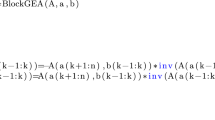Abstract
Ordinary algorithms aim to pre-order a matrix in order to achieve a favourable structure for factorization. Two prototype structures are described which are commonly aimed at by current algorithms. A different structure, based on a lower Hessenberg form, is introduced. We show that the common structures may be obtained from the Hessenberg form in a simple way. A fundamental and very simple algorithm is presented for deriving the lower Hessenberg form. This algorithm is inherently a part of other common algorithms, but is usually obscured by other detailed heuristics. Some of these heuristics are seen to correspond to different tie-break rules in the fundamental algorithm. We describe a particularly simple tie-break rule used in SPK1 [11], which is effective and not at all well known. Ordinary algorithms need to be modified to enable pivoting for numerical stability to be carried out. We describe how the idea of threshold pivoting can be used in the context of these algorithms. Most ordering algorithms in common use employ some sort of look-ahead to promote a favourable structure. It is argued that look-ahead is generally ineffective in practice, and that numerical evidence supports the use of very simple strategies. A new ordering algorithm is presented which aims to obtain a narrower bandwidth in the lower Hessenberg form. Some limited numerical experience is presented which enables us to draw tentative conclusions about various ordering strategies, and how they compare with those in common use.
Similar content being viewed by others
References
M. Arioli, I.S. Duff, N.I.M. Gould and J.K. Reid, The practical use of the Hellerman-Rarick P4 algorithm and the P5 algorithm of Erisman et al., A.E.R.E. Harwell Report CSS 213 (1987).
M. Arioli and I.S. Duff, Experiments in tearing large sparse systems, A.E.R.E. Report CSS 217 (1988).
I.S. Duff, On algorithms for obtaining a maximum transversal, A.E.R.E. Report CSS 49 (1978).
I.S. Duff and J.K. Reid, A comparison of sparsity orderings for obtaining pivotal sequences in Gaussian elimination, J. Inst. Math. Appl. 14(1974)281–291.
I.S. Duff and J.K. Reid, Algorithm 529: Permutations to block triangular form, ACM Trans. Math. Software 4(1978)189–192.
I.S. Duff, A.M. Erisman and J.K. Reid,Direct Methods for Sparse Matrices (Oxford Science Publ., Oxford, 1986).
A.M. Erisman, R.G. Grimes, J.G. Lewis and W.G. Poole, A structurally stable modification of Hellerman-Rarick's P4 algorithm for reordering unsymmetric sparse matrices, SIAM J. Numer. Anal. 22(1985)369–385.
R. Fletcher and J.A.J. Hall, Towards reliable linear programming, in:Numerical Analysis 1989, ed. D.F. Griffiths and G.A. Watson, Pitman Research Notes in Mathematics 228 (Longman, Harlow, 1990).
E. Hellerman and D.C. Rarick, The partitioned preassigned pivot procedure (P4), in:Sparse Matrices and their Applications, ed. D.J. Rose and R.A. Willoughby (Plenum Press, New York, 1972).
H.M. Markowitz, The elimination form of the inverse and its application to linear programming, Manag. Sci. 3(1957)255–269.
M.A. Stadtherr and S.E. Wood, Sparse matrix methods for equation based chemical process flowsheeting. I. Reordering phase, Comp. Chem. Eng. 8(1984)9–18.
M.A. Stadtherr and S.E. Wood, Sparse matrix methods for equation based chemical process flowsheeting. II. Numerical phase, Comp. Chem. Eng. 8(1984)19–33.
R.E. Tarjan, Depth first search and linear graph algorithms, SIAM J. Comput. 1(1972)146–160.
Author information
Authors and Affiliations
Rights and permissions
About this article
Cite this article
Fletcher, R., Hall, J.A.J. Ordering algorithms for irreducible sparse linear systems. Ann Oper Res 43, 15–32 (1993). https://doi.org/10.1007/BF02025533
Issue Date:
DOI: https://doi.org/10.1007/BF02025533




